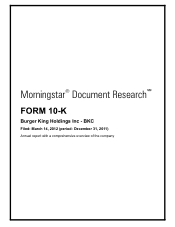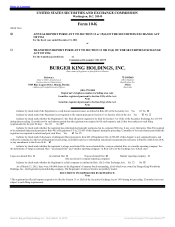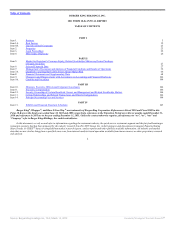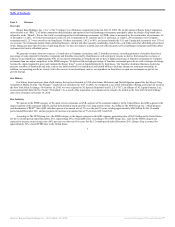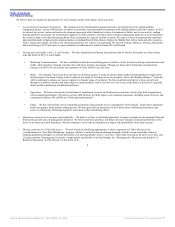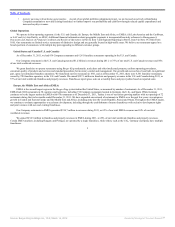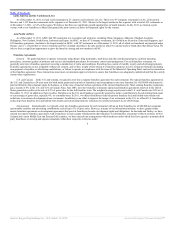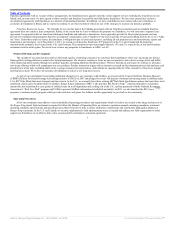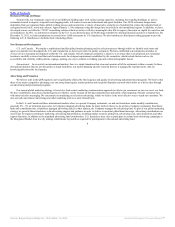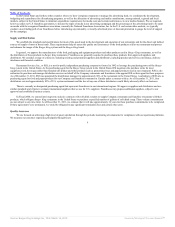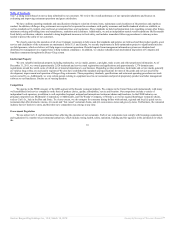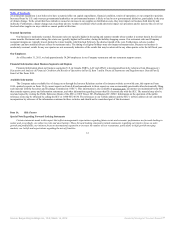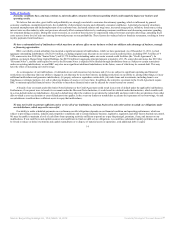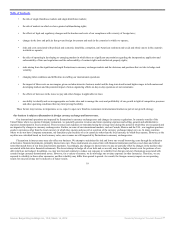Burger King 2011 Annual Report Download - page 9
Download and view the complete annual report
Please find page 9 of the 2011 Burger King annual report below. You can navigate through the pages in the report by either clicking on the pages listed below, or by using the keyword search tool below to find specific information within the annual report.
Table of Contents
Restaurant Design and Image
System-wide, our restaurants consist of several different building types with various seating capacities, including free-standing buildings, as well as
restaurants located in airports, strip malls and shopping malls, toll road rest areas and educational and sports facilities. Our 20/20 restaurant design draws
inspiration from our signature flame-grilled cooking process and incorporates a variety of innovative elements to a backdrop that evokes the industrial look of
corrugated metal, brick, wood and concrete. Approximately 1,114 restaurants using this design have been built in our international regions. In addition, we have
developed a more cost effective “20/20” remodeling solution which we believe will drive meaningful sales lifts to improve the return on capital for ourselves and
our franchisees. In 2011, we instituted an initiative in the U.S. to accelerate the pace of 20/20 image remodels by offering financial incentives to franchisees. By
December 31, 2011, we had commitments to remodel over 1,000 restaurants by U.S. franchisees. We also introduced a third party lending program to provide
financing to U.S. franchisees to facilitate their remodeling efforts.
New Restaurant Development
U.S. and Canada. We employ a sophisticated and disciplined market planning and site selection process through which we identify trade areas and
approve restaurant sites throughout the U.S. and Canada that we believe provides for quality expansion. We have established a development committee to
oversee all new restaurant development within the U.S. and Canada. Our development committee’s objective is to ensure that every proposed new restaurant
location is carefully reviewed and that each location meets the stringent requirements established by the committee, which include factors such as site
accessibility and visibility, traffic patterns, signage, parking, site size in relation to building type and certain demographic factors.
International. In several of our international markets, there is a single franchisee that owns and operates all of the restaurants within a country. In those
international markets that are not allocated to a single franchisee, our market planning and site selection process is managed by regional teams, who are
knowledgeable about the local market.
Advertising and Promotion
We believe sales in the QSR segment can be significantly affected by the frequency and quality of advertising and promotional programs. We believe that
three of our major competitive advantages are our strong brand equity, market position and our global franchise network which allow us to drive sales through
our advertising and promotional programs.
Our current global marketing strategy is based on a food-centric marketing communication approach to refocus our consumers on our core asset: our food.
We have established a data driven marketing process which is clearly focused on driving restaurant sales and traffic, while targeting a broader consumer base
with more inclusive messaging. We concentrate our marketing on television advertising, which we believe is the most effective way to reach our customers. We
also use radio and internet advertising and other marketing tools on a more limited basis.
In the U.S. and Canada and those international markets where we operate Company restaurants, we and our franchisees make monthly contributions,
generally 4% – 5% of restaurant gross sales, to Company managed advertising funds. In many markets where we do not have Company restaurants, franchisees
make this contribution into a franchisee managed advertising fund. In other markets, the Company manages the advertising fund. As part of our global marketing
strategy, we provide these franchisees with advertising support and guidance in order to deliver a consistent global brand message. Advertising contributions are
used to pay for expenses relating to marketing, advertising and promotion, including market research, production, advertising costs, sales promotions and other
support functions. In addition to the mandated advertising fund contributions, U.S. franchisees may elect to participate in certain local advertising campaigns at
the Designated Market Area level by making contributions beyond those required for participation in the national advertising fund.
8
Source: Burger King Holdings Inc, 10-K, March 14, 2012 Powered by Morningstar® Document Research℠

